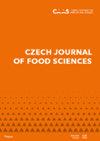Foam-mat convective drying of kiwiberry (Actinidia arguta) pulp
IF 1
4区 农林科学
Q4 FOOD SCIENCE & TECHNOLOGY
引用次数: 0
Abstract
The purpose of this work has been to determine the optimal conditions for the processing of kiwiberry fruit pulp based on the relevant thickness of the layer and air temperature, that will target the maximal reduction of drying time and minimal energy consumption. The research was designed to use the response surface methodology (RSM). The effects of independent variables (factors) such as the thickness of the layer (4, 8, and 12 mm) and the temperature of the drying air (50, 60, and 70°C) were studied by the means of the response variables. In this study, the drying kinetics was evaluated based on the drying time, drying rate, and effective water diffusion coefficient (Deff). Based on the simplified Fick's second law of diffusion, Deff was determined, while the relative water content [moisture ratio (MR)] was predicted using empirical models. It was found that as the temperature of the drying process increased, the process time was reduced, and the drying process intensified, which was manifested by the increment of the drying rate as well as the effective moisture diffusivity (varied from 5.58 × 10–10 m2 s–1 to 27.2 × 10–10 m2 s–1). The mathematical model, developed using the RSM, showed a good fit for the data obtained in the study, which allowed to predict the response of the effective water Deff of the foamed kiwiberry fruit pulp with R2 > 0.97.猕猴桃果肉泡沫垫对流干燥研究
本研究的目的是根据猕猴桃果肉的相关层厚和空气温度来确定猕猴桃果肉的最佳加工条件,以最大限度地缩短干燥时间和最小的能耗为目标。本研究采用响应面法(RSM)。通过响应变量研究了层厚(4、8、12 mm)和干燥空气温度(50、60、70℃)等自变量(因子)的影响。在这项研究中,根据干燥时间、干燥速率和有效水扩散系数(Deff)来评估干燥动力学。基于简化的菲克第二扩散定律确定了Deff,并利用经验模型预测了相对含水量[含水率(MR)]。研究发现,随着干燥温度的升高,干燥时间缩短,干燥过程加剧,表现为干燥速率和有效水分扩散率的增加(从5.58 × 10-10 m2 s-1增加到27.2 × 10-10 m2 s-1)。利用RSM建立的数学模型与实验数据拟合较好,可以预测发泡猕猴桃果肉的有效含水率响应R2为> 0.97。
本文章由计算机程序翻译,如有差异,请以英文原文为准。
求助全文
约1分钟内获得全文
求助全文
来源期刊

Czech Journal of Food Sciences
Food Science & Technology, Chemistry-食品科技
CiteScore
2.60
自引率
0.00%
发文量
48
审稿时长
7 months
期刊介绍:
Original research, critical review articles, and short communications dealing with food technology and processing (including food biochemistry, mikrobiology, analyse, engineering, nutrition and economy). Papers are published in English.
 求助内容:
求助内容: 应助结果提醒方式:
应助结果提醒方式:


